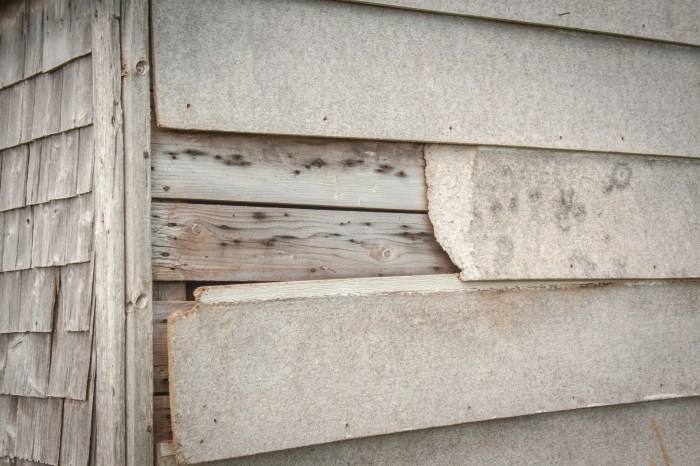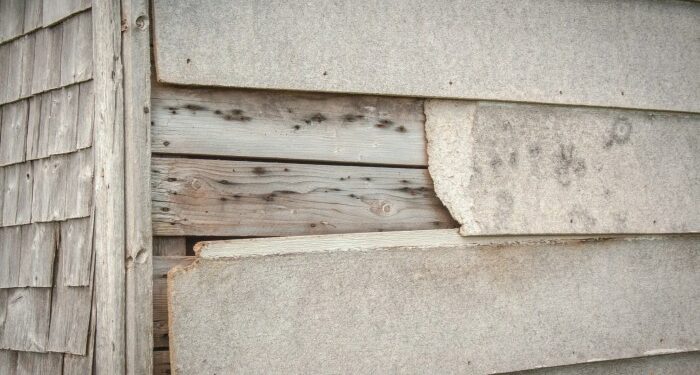Damaged siding is a common issue that many homeowners face, caused by a variety of factors ranging from weather conditions to pests. Understanding the causes, types, repair methods, and prevention strategies can help you maintain the integrity of your home's exterior.
Let's delve into the world of damaged siding and uncover essential insights to protect your property.
Common Causes of Damaged Siding
Damaged siding can be caused by a variety of factors, ranging from severe weather conditions to improper installation and even pest infestations. Understanding these causes can help homeowners prevent and address siding damage effectively.
Weather Conditions
Weather conditions such as hail, strong winds, and heavy rains can wreak havoc on siding materials. Hail can cause dents and cracks, while strong winds can loosen or tear off siding panels. Heavy rains can lead to water damage, mold growth, and rotting of the siding material.
Improper Installation and Maintenance
Improper installation of siding can create weak spots and vulnerabilities that are prone to damage. Additionally, a lack of regular maintenance, such as cleaning and inspections, can allow issues to go unnoticed and worsen over time. Proper installation and timely maintenance are crucial for the longevity of siding.
Pest Infestations
Pests like termites and woodpeckers can also contribute to siding damage. Termites can feed on the wood components of siding, causing structural weakening and deterioration. Woodpeckers, on the other hand, can peck at siding to create holes for nesting or foraging, compromising its integrity.
Types of Damaged Siding
When it comes to siding materials, different types can be damaged in various ways. Understanding the signs of damage is crucial in maintaining the integrity of your home's exterior.
Vinyl Siding
Vinyl siding is prone to cracking and fading over time due to exposure to sunlight and extreme weather conditions. Signs of damaged vinyl siding may include cracks, warping, or discoloration.
Wood Siding
Wood siding is susceptible to rotting, warping, and insect infestations. Water infiltration can cause wood siding to deteriorate, leading to visible signs such as mold growth or soft spots.
Fiber Cement Siding
Fiber cement siding is durable but can still be damaged by impact or improper installation. Look out for cracks, chips, or delamination as signs of damage to fiber cement siding.
Metal Siding
Metal siding can dent or corrode over time, especially in areas prone to high humidity or salt exposure. Keep an eye out for rust spots, dents, or discoloration on metal siding.
Age-Related Deterioration
Regardless of the material, all types of siding can deteriorate with age. Look for signs such as peeling paint, fading colors, or overall wear and tear to determine if your siding needs repair or replacement.
Repairing Damaged Siding

Repairing damaged siding is essential to maintain the integrity and aesthetics of your home. Whether the damage is minor or extensive, addressing it promptly can prevent further issues down the line.
Assessing the Extent of Siding Damage
Before starting any repairs, it's crucial to assess the extent of the siding damage. Look for signs of cracks, holes, warping, or discoloration. Determine if the damage is isolated to a specific area or if it extends to other sections of the siding.
Common DIY Repair Techniques for Minor Siding Damage
- Use a caulking gun to fill in small cracks and holes.
- Replace individual damaged siding panels with new ones.
- Repaint or touch up areas with peeling or chipped paint.
When to Seek Professional Help for Siding Repairs
- If the damage is extensive or affects a large area, it's best to hire a professional siding contractor.
- If you lack the necessary tools or experience to repair the siding properly, seeking professional help is advisable.
- Professional help may also be needed if the siding damage is due to underlying structural issues.
Tips for Matching New Siding with Existing Siding
Matching new siding with existing siding is crucial for a seamless repair job. Here are some tips to ensure a perfect match:
- Take a sample of the existing siding to the store to find a similar color and texture.
- If the exact match is not available, consider repainting the entire section for a uniform look.
- Consult with a professional to help you identify the best matching siding options.
Preventing Future Damage to Siding
Proper maintenance practices are essential in preventing damage to your siding and ensuring its longevity. Regular inspections and cleaning routines can help identify issues early on and prevent them from escalating. Additionally, protecting your siding from pests and environmental factors, as well as choosing durable materials, can significantly minimize the risk of future damage.
Maintenance Practices
Regularly inspect your siding for any signs of damage, such as cracks, holes, or warping. Address any issues immediately to prevent them from worsening over time. Clean your siding periodically to remove dirt, mold, and mildew, which can cause deterioration.
Protection from Pests and Environmental Factors
Seal any gaps or openings in your siding to prevent pests like insects and rodents from nesting inside. Trim back vegetation near your home to reduce the risk of moisture damage and pest infestations. Install gutter guards to prevent clogs and water damage to your siding.
Choosing Durable Materials
Consider using siding materials that are resistant to moisture, insects, and UV rays to minimize future damage. Fiber cement, vinyl, and metal siding are popular choices known for their durability and low maintenance requirements. Consult with a professional to determine the best option for your home.
Closing Notes
In conclusion, damaged siding is a significant concern that requires timely attention and proper maintenance. By being aware of the causes, types, repair options, and prevention techniques discussed, you can effectively safeguard your siding and prolong its lifespan. Stay informed, stay proactive, and ensure your home remains a safe and beautiful haven for years to come.
FAQ Explained
What are the common causes of damaged siding?
Common causes include weather conditions like hail and strong winds, improper installation, maintenance issues, and damage from pests like termites.
How can I identify types of damaged siding?
Look for visible signs such as cracks, warping, or discoloration. Water infiltration and impact damage can also cause different types of damage.
When should I seek professional help for siding repairs?
If the damage is extensive or if you're unsure about the repair process, it's best to consult a professional to ensure the job is done correctly.
What maintenance practices can prevent future siding damage?
Regular inspections, cleaning routines, and protecting siding from pests and environmental factors can help prevent future damage.
How do I match new siding with existing siding during repairs?
Consult with professionals to ensure new siding matches existing ones, creating a seamless repair that blends well with the overall look of your home.












